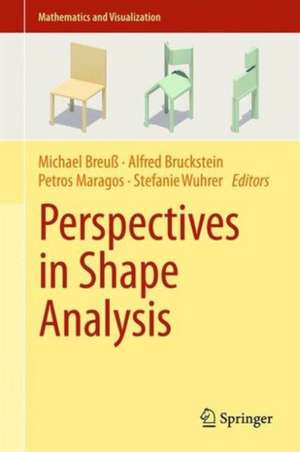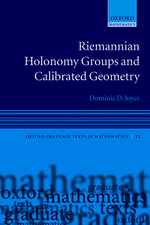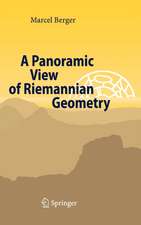Perspectives in Shape Analysis: Mathematics and Visualization
Editat de Michael Breuß, Alfred Bruckstein, Petros Maragos, Stefanie Wuhreren Limba Engleză Hardback – oct 2016
The goal of the Dagstuhl Seminar on New Perspectives in Shape Analysis held in February 2014 was to address these challenges with the help of the latest tools related to geometric, algorithmic and numerical concepts and to bring together researchers at the forefront of shape analysis who can work together to identify open problems and novel solutions. The book resulting from this seminar will appeal to researchers in the field of shape analysis,image and vision, from those who want to become more familiar with the field, to experts interested in learning about the latest advances.
| Toate formatele și edițiile | Preț | Express |
|---|---|---|
| Paperback (1) | 790.84 lei 38-44 zile | |
| Springer International Publishing – 14 iun 2018 | 790.84 lei 38-44 zile | |
| Hardback (1) | 960.93 lei 3-5 săpt. | |
| Springer International Publishing – oct 2016 | 960.93 lei 3-5 săpt. |
Din seria Mathematics and Visualization
- 20%
 Preț: 935.20 lei
Preț: 935.20 lei - 18%
 Preț: 1110.41 lei
Preț: 1110.41 lei - 20%
 Preț: 994.26 lei
Preț: 994.26 lei - 18%
 Preț: 1220.57 lei
Preț: 1220.57 lei - 18%
 Preț: 958.38 lei
Preț: 958.38 lei - 15%
 Preț: 654.62 lei
Preț: 654.62 lei - 20%
 Preț: 997.38 lei
Preț: 997.38 lei - 15%
 Preț: 645.47 lei
Preț: 645.47 lei - 5%
 Preț: 1101.58 lei
Preț: 1101.58 lei - 20%
 Preț: 992.44 lei
Preț: 992.44 lei - 20%
 Preț: 1284.47 lei
Preț: 1284.47 lei - 20%
 Preț: 656.69 lei
Preț: 656.69 lei - 20%
 Preț: 476.68 lei
Preț: 476.68 lei - 20%
 Preț: 1273.08 lei
Preț: 1273.08 lei - 15%
 Preț: 649.54 lei
Preț: 649.54 lei - 20%
 Preț: 335.36 lei
Preț: 335.36 lei - 20%
 Preț: 646.95 lei
Preț: 646.95 lei - 20%
 Preț: 651.75 lei
Preț: 651.75 lei - 20%
 Preț: 657.99 lei
Preț: 657.99 lei - 18%
 Preț: 1223.74 lei
Preț: 1223.74 lei - 20%
 Preț: 333.72 lei
Preț: 333.72 lei - 20%
 Preț: 709.98 lei
Preț: 709.98 lei - 18%
 Preț: 1236.38 lei
Preț: 1236.38 lei - 20%
 Preț: 992.26 lei
Preț: 992.26 lei - 20%
 Preț: 648.44 lei
Preț: 648.44 lei - 20%
 Preț: 1158.59 lei
Preț: 1158.59 lei - 20%
 Preț: 330.66 lei
Preț: 330.66 lei - 18%
 Preț: 963.91 lei
Preț: 963.91 lei - 15%
 Preț: 653.98 lei
Preț: 653.98 lei - 20%
 Preț: 991.94 lei
Preț: 991.94 lei - 18%
 Preț: 958.07 lei
Preț: 958.07 lei
Preț: 960.93 lei
Preț vechi: 1171.86 lei
-18% Nou
Puncte Express: 1441
Preț estimativ în valută:
183.87€ • 191.98$ • 152.18£
183.87€ • 191.98$ • 152.18£
Carte disponibilă
Livrare economică 15-29 martie
Preluare comenzi: 021 569.72.76
Specificații
ISBN-13: 9783319247243
ISBN-10: 3319247247
Pagini: 350
Ilustrații: XVII, 370 p. 144 illus., 82 illus. in color.
Dimensiuni: 155 x 235 x 24 mm
Greutate: 0.89 kg
Ediția:1st ed. 2016
Editura: Springer International Publishing
Colecția Springer
Seria Mathematics and Visualization
Locul publicării:Cham, Switzerland
ISBN-10: 3319247247
Pagini: 350
Ilustrații: XVII, 370 p. 144 illus., 82 illus. in color.
Dimensiuni: 155 x 235 x 24 mm
Greutate: 0.89 kg
Ediția:1st ed. 2016
Editura: Springer International Publishing
Colecția Springer
Seria Mathematics and Visualization
Locul publicării:Cham, Switzerland
Cuprins
Part I Numerical Computing for Shape Analysis: 1 Ornament Analysis with the Help of Screened Poisson Shape Fields: S. Tari.- 2 A Comparison of Non-Lambertian Models for the Shape-from-Shading Problem: S. Tozza and M. Falcone.- 3 Direct Variational Perspective Shape from Shading with Cartesian Depth Parameterisation Y. Chul Ju et al.- 4 Amoeba Techniques for Shape and Texture Analysis: M. Welk.- 5 Increasing the Power of Shape Descriptor Based Object Analysis Techniques: J. Zuníc et al.- 6 Shape Distances for Binary Image Segmentation F.R. Schmidt et al.- 7 Segmentation in Point Clouds from RGB-D using Spectral Graph Reduction: M. Keuper and Th. Brox.- Part II Sparse Data Representation and Machine Learning for Shape Analysis: 8 Shape Compaction: H. Li and H. Zhang.- 9 Homological Shape Analysis through Discrete Morse Theory: L. de Floriani et al.- 10 Sparse Modeling of Intrinsic Correspondences: J. Pokrass et al.- 11 Applying Random Forests to the Problem of Dense Non-Rigid Shape Correspondence: M. Vestner et al.- 12 Accelerating Deformable Part Models with Branch-and-Bound: I. Kokkinos.- Part III Deformable Shape Modeling: 13 Non-Rigid Shape Correspondence in the Spectral Domain: A. Dubrovina.- 14 The Perspective Face Shape Ambiguity: W.A.P. Smith.- 15 On Shape Recognition and Language: P. Maragos.- 16 Tongue Mesh Extraction from 3D MRI Data of the Human Vocal Tract: A. Hewer et al.
Textul de pe ultima copertă
This book presents recent advances in the field of shape analysis. Written by experts in the fields of continuous-scale shape analysis, discrete shape analysis and sparsity, and numerical computing who hail from different communities, it provides a unique view of the topic from a broad range of perspectives.
Over the last decade, it has become increasingly affordable to digitize shape information at high resolution. Yet analyzing and processing this data remains challenging because of the large amount of data involved, and because modern applications such as human-computer interaction require real-time processing. Meeting these challenges requires interdisciplinary approaches that combine concepts from a variety of research areas, including numerical computing, differential geometry, deformable shape modeling, sparse data representation, and machine learning. On the algorithmic side, many shape analysis tasks are modeled using partial differential equations, which can be solved using tools from the field of numerical computing. The fields of differential geometry and deformable shape modeling have recently begun to influence shape analysis methods. Furthermore, tools from the field of sparse representations, which aim to describe input data using a compressible representation with respect to a set of carefully selected basic elements, have the potential to significantly reduce the amount of data that needs to be processed in shape analysis tasks. The related field of machine learning offers similar potential.
The goal of the Dagstuhl Seminar on New Perspectives in Shape Analysis held in February 2014 was to address these challenges with the help of the latest tools related to geometric, algorithmic and numerical concepts and to bring together researchers at the forefront of shape analysis who can work together to identify open problems and novel solutions. The book resulting from this seminar will appeal to researchers in the field of shape analysis,image and vision, from those who want to become more familiar with the field, to experts interested in learning about the latest advances.
The goal of the Dagstuhl Seminar on New Perspectives in Shape Analysis held in February 2014 was to address these challenges with the help of the latest tools related to geometric, algorithmic and numerical concepts and to bring together researchers at the forefront of shape analysis who can work together to identify open problems and novel solutions. The book resulting from this seminar will appeal to researchers in the field of shape analysis,image and vision, from those who want to become more familiar with the field, to experts interested in learning about the latest advances.
Caracteristici
Presentation of recent advances in the field of shape analysis Written by experts in the field of shape analysis who are part of different communities Provides a unique view of the topic from a variety of perspectives?

















